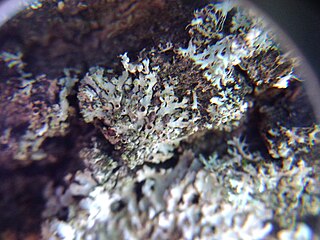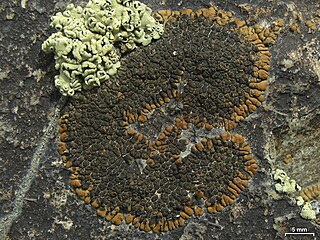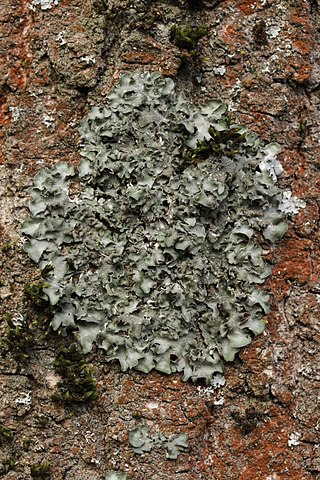Scutula is a genus of lichenicolous fungi in the family Ramalinaceae.

The Lecanoraceae are a family of lichenized fungi in the order Lecanorales. Species of this family have a widespread distribution.

Lichenochora is a genus of fungi in the family Phyllachoraceae. It has 44 species. All species in the genus are lichenicolous, meaning they grow parasitically on lichens. The genus was circumscribed by Josef Hafellner in 1989, with Lichenochora thallina assigned as the type species.

Sphaerellothecium is a genus of fungi in the family Phyllachoraceae. All of the species in the genus are lichenicolous, meaning they grow parasitically on lichens.

The Lecideaceae are a family of lichens in the order Lecideales.
Cecidonia is a genus of lichenicolous fungi in the family Lecideaceae. It has two species. The genus was circumscribed in 1988 by Dagmar Triebel and Gerhard Rambold, with C. umbonella assigned as the type species.

Ropalospora is a genus of lichen-forming fungi, and the sole member of the monogeneric family Ropalosporaceae. The genus was circumscribed by Italian lichenologist Abramo Bartolommeo Massalongo in 1860. The family was proposed by Josef Hafellner in 1984.

Nesolechia is a genus of parasitic fungi in the family Parmeliaceae. All three species in the genus grow on lichens. Nesolechia probably evolved from a lichen ancestor, as it is closely related to many lichenized species of fungi.

Phacopsis is a genus of lichenicolous (lichen-dwelling) fungi. They are parasites of members of the large lichen family Parmeliaceae, of which they are also a member. Originally proposed by Edmond Tulasne in 1852 to contain 3 species, Phacopsis now contains 10 species, although historically, 33 taxa have been described in the genus. Many of the species are poorly known, some of them having been documented only from the type specimen.

Diploicia canescens is a widespread species of lichenized fungus. It is found throughout much of the world, occurring on every continent except Antarctica.

Pleurosticta acetabulum is a species of foliose lichen in the family Parmeliaceae. It is common and widespread throughout Europe, where it grows on tree bark. It has also been recorded in Algeria.

Solenopsora is a genus of lichen-forming fungi in the family Catillariaceae. It has 15 species, with a mostly Northern Hemisphere distribution.

Schaereria is a genus of lichen-forming fungi. It is the sole genus in the family Schaereriaceae, which itself is the only family in the Schaereriales, an order in the subclass Ostropomycetidae of the class Lecanoromycetes. Most Schaereria species are crustose lichens that live on rocks. Schaereria was first proposed by Gustav Wilhelm Körber in 1855 and was later taken up by other lichenologists despite periods of disuse.

Sporastatia is a genus of crustose lichens in the family Sporastatiaceae. It has four species. Sporastatia lichens are long-lived species that grow on siliceous or weakly calcareous rocks in arctic and alpine locales.
Raesaenenia is a fungal genus in the large family Parmeliaceae. It is a monotypic genus, containing the single lichenicolous fungus Raesaenenia huuskonenii, which parasitises lichens of genus Bryoria in the Northern Hemisphere.
Phacopsis australis is a species of lichenicolous (lichen-dwelling) fungus in the family Parmeliaceae. It is found in a few locations in South Africa, where it grows on the thalli of several species of the leafy lichen genus Xanthoparmelia. Unlike other members of genus Phacopsis, the fungus does not induce the formation of galls in its host.
Phacopsis lethariellae is a species of lichenicolous (lichen-dwelling) fungus in the family Parmeliaceae. It was formally described as a new species in 1995 by Josef Hafellner and Gerhard Rambold. The type specimen was collected by the first author from La Fortaleza at an altitude of 1,180 m (3,870 ft), where it was found growing on the thallus of the lichen Lethariella intricata. It causes formations of galls, which also creates a torsion on the thallus. It has dark brown to black apothecia that are typically 0.3–0.5 mm in diameter, with a convex disc. Its ascospores are ellipsoid to ovoid, measuring 11–13 by 6–7 μm. The fungus, known to occur only in the Canary Islands, is named after the genus of its host.
Henricus (Harrie) Johannes Maria Sipman is a Dutch lichenologist. He specialises in tropical and subtropical lichens, and has authored or co-authored more than 250 scientific publications. He was the curator of the lichen herbarium at the Berlin Botanical Garden and Botanical Museum from 1983 until his retirement in 2010.

Phacopsis vulpina is a species of lichenicolous (lichen-dwelling) fungus in the family Parmeliaceae, and the type species of the genus Phacopsis. It was formally described as a new species in 1852 by French mycologist Edmond Tulasne. The fungus is restricted to the genus Letharia as a host and consequently has a Northern Hemisphere distribution. Externally, it is somewhat similar in appearance to P. lethariellae, but P. vulpina does not have a brown hypothecium.

Piccolia is a small genus of crustose lichens in the class Lecanoromycetes. First circumscribed by Italian lichenologist Abramo Bartolommeo Massalongo in 1864, it contains ten species. Due to a lack of molecular data, it has not been assigned to an order or family.













